Literature Review: Behavioral Finance in Corporate Finance
VerifiedAdded on 2023/01/11
|5
|1178
|52
Literature Review
AI Summary
This literature review examines the field of behavioral finance, focusing on the influence of psychology on investor behavior and financial markets. It challenges the assumptions of rational decision-making, highlighting cognitive biases and emotional influences. The review explores key concepts such as the Behavioral Portfolio Theory (BPT) and the Behavioral Asset Pricing Model (BAPM), contrasting them with traditional financial theories. It also discusses the application of behavioral finance in corporate finance, emphasizing the importance of understanding human behavior in resource allocation and decision-making. The review references key works by researchers like Kahneman and Thaler, and explores the implications of behavioral finance for corporate governance and financial performance. The document provides a comprehensive overview of the subject, synthesizing various perspectives and research findings in the field of behavioral finance.
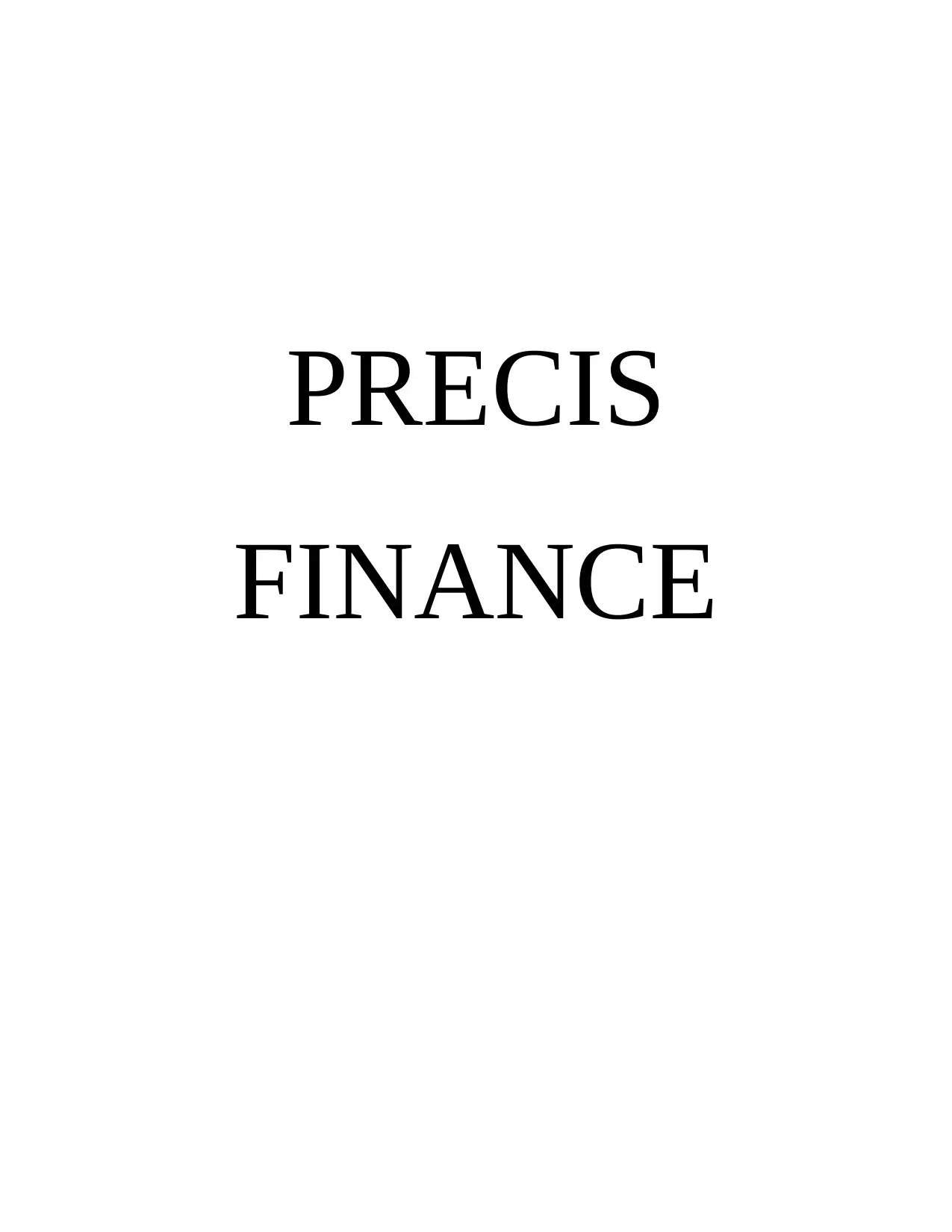
PRECIS
FINANCE
FINANCE
Paraphrase This Document
Need a fresh take? Get an instant paraphrase of this document with our AI Paraphraser
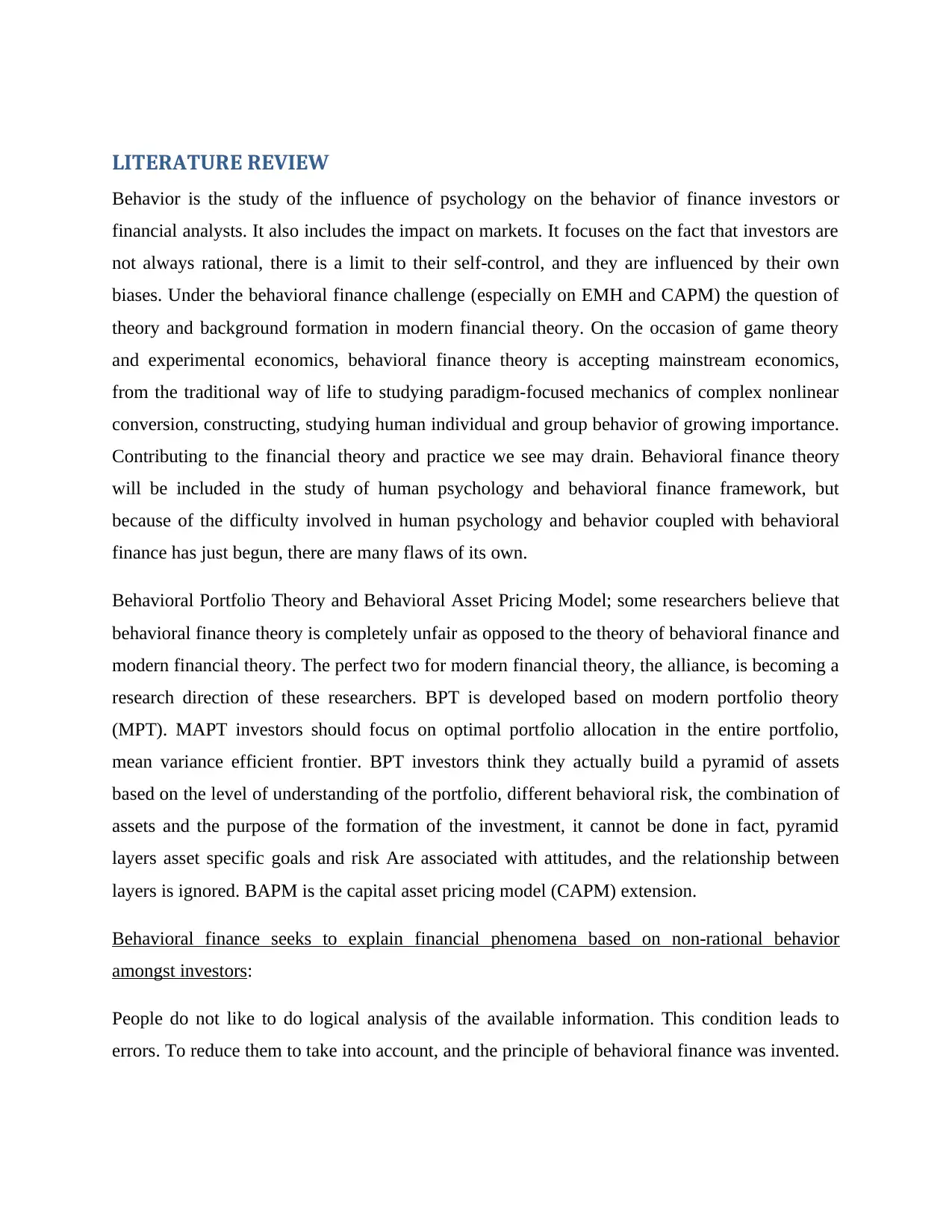
LITERATURE REVIEW
Behavior is the study of the influence of psychology on the behavior of finance investors or
financial analysts. It also includes the impact on markets. It focuses on the fact that investors are
not always rational, there is a limit to their self-control, and they are influenced by their own
biases. Under the behavioral finance challenge (especially on EMH and CAPM) the question of
theory and background formation in modern financial theory. On the occasion of game theory
and experimental economics, behavioral finance theory is accepting mainstream economics,
from the traditional way of life to studying paradigm-focused mechanics of complex nonlinear
conversion, constructing, studying human individual and group behavior of growing importance.
Contributing to the financial theory and practice we see may drain. Behavioral finance theory
will be included in the study of human psychology and behavioral finance framework, but
because of the difficulty involved in human psychology and behavior coupled with behavioral
finance has just begun, there are many flaws of its own.
Behavioral Portfolio Theory and Behavioral Asset Pricing Model; some researchers believe that
behavioral finance theory is completely unfair as opposed to the theory of behavioral finance and
modern financial theory. The perfect two for modern financial theory, the alliance, is becoming a
research direction of these researchers. BPT is developed based on modern portfolio theory
(MPT). MAPT investors should focus on optimal portfolio allocation in the entire portfolio,
mean variance efficient frontier. BPT investors think they actually build a pyramid of assets
based on the level of understanding of the portfolio, different behavioral risk, the combination of
assets and the purpose of the formation of the investment, it cannot be done in fact, pyramid
layers asset specific goals and risk Are associated with attitudes, and the relationship between
layers is ignored. BAPM is the capital asset pricing model (CAPM) extension.
Behavioral finance seeks to explain financial phenomena based on non-rational behavior
amongst investors:
People do not like to do logical analysis of the available information. This condition leads to
errors. To reduce them to take into account, and the principle of behavioral finance was invented.
Behavior is the study of the influence of psychology on the behavior of finance investors or
financial analysts. It also includes the impact on markets. It focuses on the fact that investors are
not always rational, there is a limit to their self-control, and they are influenced by their own
biases. Under the behavioral finance challenge (especially on EMH and CAPM) the question of
theory and background formation in modern financial theory. On the occasion of game theory
and experimental economics, behavioral finance theory is accepting mainstream economics,
from the traditional way of life to studying paradigm-focused mechanics of complex nonlinear
conversion, constructing, studying human individual and group behavior of growing importance.
Contributing to the financial theory and practice we see may drain. Behavioral finance theory
will be included in the study of human psychology and behavioral finance framework, but
because of the difficulty involved in human psychology and behavior coupled with behavioral
finance has just begun, there are many flaws of its own.
Behavioral Portfolio Theory and Behavioral Asset Pricing Model; some researchers believe that
behavioral finance theory is completely unfair as opposed to the theory of behavioral finance and
modern financial theory. The perfect two for modern financial theory, the alliance, is becoming a
research direction of these researchers. BPT is developed based on modern portfolio theory
(MPT). MAPT investors should focus on optimal portfolio allocation in the entire portfolio,
mean variance efficient frontier. BPT investors think they actually build a pyramid of assets
based on the level of understanding of the portfolio, different behavioral risk, the combination of
assets and the purpose of the formation of the investment, it cannot be done in fact, pyramid
layers asset specific goals and risk Are associated with attitudes, and the relationship between
layers is ignored. BAPM is the capital asset pricing model (CAPM) extension.
Behavioral finance seeks to explain financial phenomena based on non-rational behavior
amongst investors:
People do not like to do logical analysis of the available information. This condition leads to
errors. To reduce them to take into account, and the principle of behavioral finance was invented.
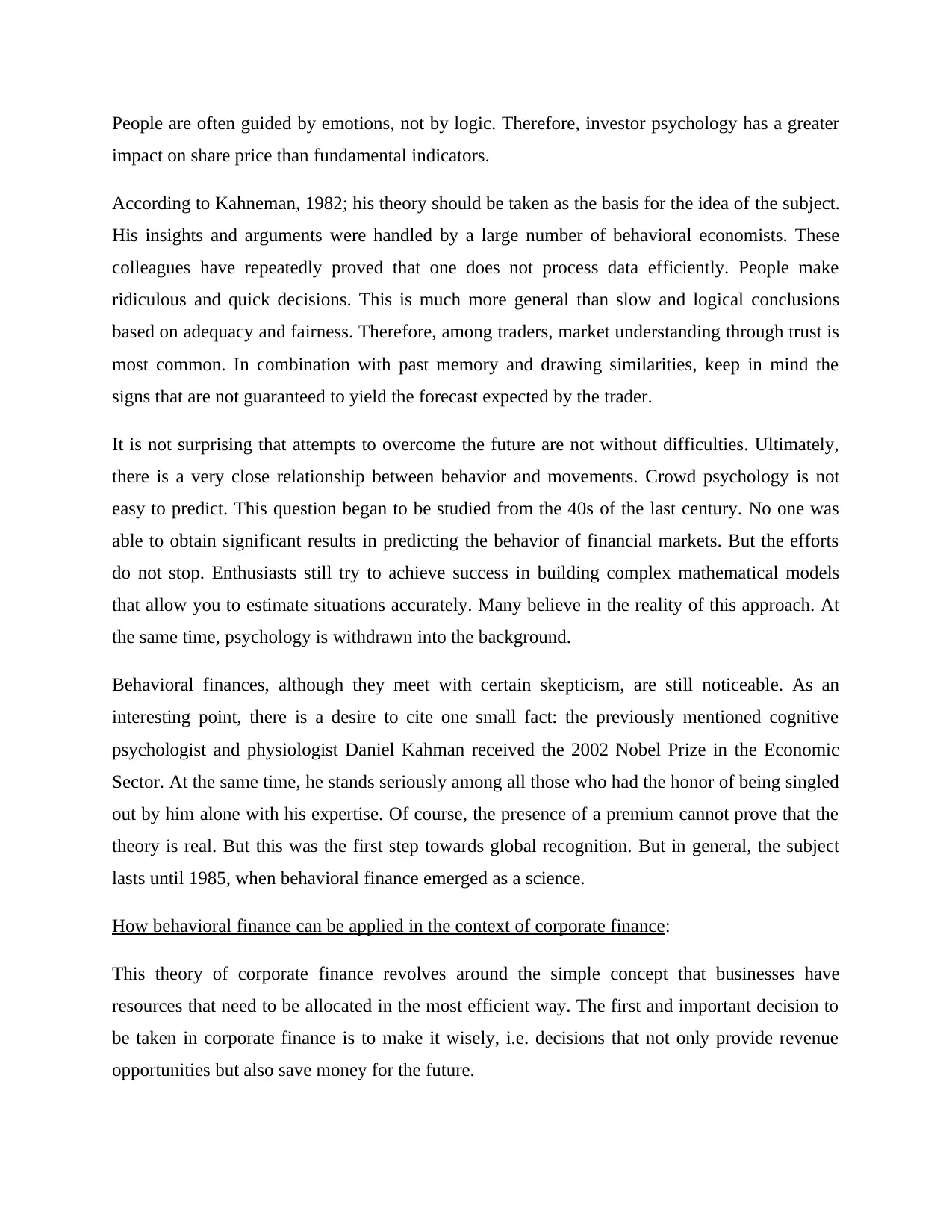
People are often guided by emotions, not by logic. Therefore, investor psychology has a greater
impact on share price than fundamental indicators.
According to Kahneman, 1982; his theory should be taken as the basis for the idea of the subject.
His insights and arguments were handled by a large number of behavioral economists. These
colleagues have repeatedly proved that one does not process data efficiently. People make
ridiculous and quick decisions. This is much more general than slow and logical conclusions
based on adequacy and fairness. Therefore, among traders, market understanding through trust is
most common. In combination with past memory and drawing similarities, keep in mind the
signs that are not guaranteed to yield the forecast expected by the trader.
It is not surprising that attempts to overcome the future are not without difficulties. Ultimately,
there is a very close relationship between behavior and movements. Crowd psychology is not
easy to predict. This question began to be studied from the 40s of the last century. No one was
able to obtain significant results in predicting the behavior of financial markets. But the efforts
do not stop. Enthusiasts still try to achieve success in building complex mathematical models
that allow you to estimate situations accurately. Many believe in the reality of this approach. At
the same time, psychology is withdrawn into the background.
Behavioral finances, although they meet with certain skepticism, are still noticeable. As an
interesting point, there is a desire to cite one small fact: the previously mentioned cognitive
psychologist and physiologist Daniel Kahman received the 2002 Nobel Prize in the Economic
Sector. At the same time, he stands seriously among all those who had the honor of being singled
out by him alone with his expertise. Of course, the presence of a premium cannot prove that the
theory is real. But this was the first step towards global recognition. But in general, the subject
lasts until 1985, when behavioral finance emerged as a science.
How behavioral finance can be applied in the context of corporate finance:
This theory of corporate finance revolves around the simple concept that businesses have
resources that need to be allocated in the most efficient way. The first and important decision to
be taken in corporate finance is to make it wisely, i.e. decisions that not only provide revenue
opportunities but also save money for the future.
impact on share price than fundamental indicators.
According to Kahneman, 1982; his theory should be taken as the basis for the idea of the subject.
His insights and arguments were handled by a large number of behavioral economists. These
colleagues have repeatedly proved that one does not process data efficiently. People make
ridiculous and quick decisions. This is much more general than slow and logical conclusions
based on adequacy and fairness. Therefore, among traders, market understanding through trust is
most common. In combination with past memory and drawing similarities, keep in mind the
signs that are not guaranteed to yield the forecast expected by the trader.
It is not surprising that attempts to overcome the future are not without difficulties. Ultimately,
there is a very close relationship between behavior and movements. Crowd psychology is not
easy to predict. This question began to be studied from the 40s of the last century. No one was
able to obtain significant results in predicting the behavior of financial markets. But the efforts
do not stop. Enthusiasts still try to achieve success in building complex mathematical models
that allow you to estimate situations accurately. Many believe in the reality of this approach. At
the same time, psychology is withdrawn into the background.
Behavioral finances, although they meet with certain skepticism, are still noticeable. As an
interesting point, there is a desire to cite one small fact: the previously mentioned cognitive
psychologist and physiologist Daniel Kahman received the 2002 Nobel Prize in the Economic
Sector. At the same time, he stands seriously among all those who had the honor of being singled
out by him alone with his expertise. Of course, the presence of a premium cannot prove that the
theory is real. But this was the first step towards global recognition. But in general, the subject
lasts until 1985, when behavioral finance emerged as a science.
How behavioral finance can be applied in the context of corporate finance:
This theory of corporate finance revolves around the simple concept that businesses have
resources that need to be allocated in the most efficient way. The first and important decision to
be taken in corporate finance is to make it wisely, i.e. decisions that not only provide revenue
opportunities but also save money for the future.
⊘ This is a preview!⊘
Do you want full access?
Subscribe today to unlock all pages.

Trusted by 1+ million students worldwide
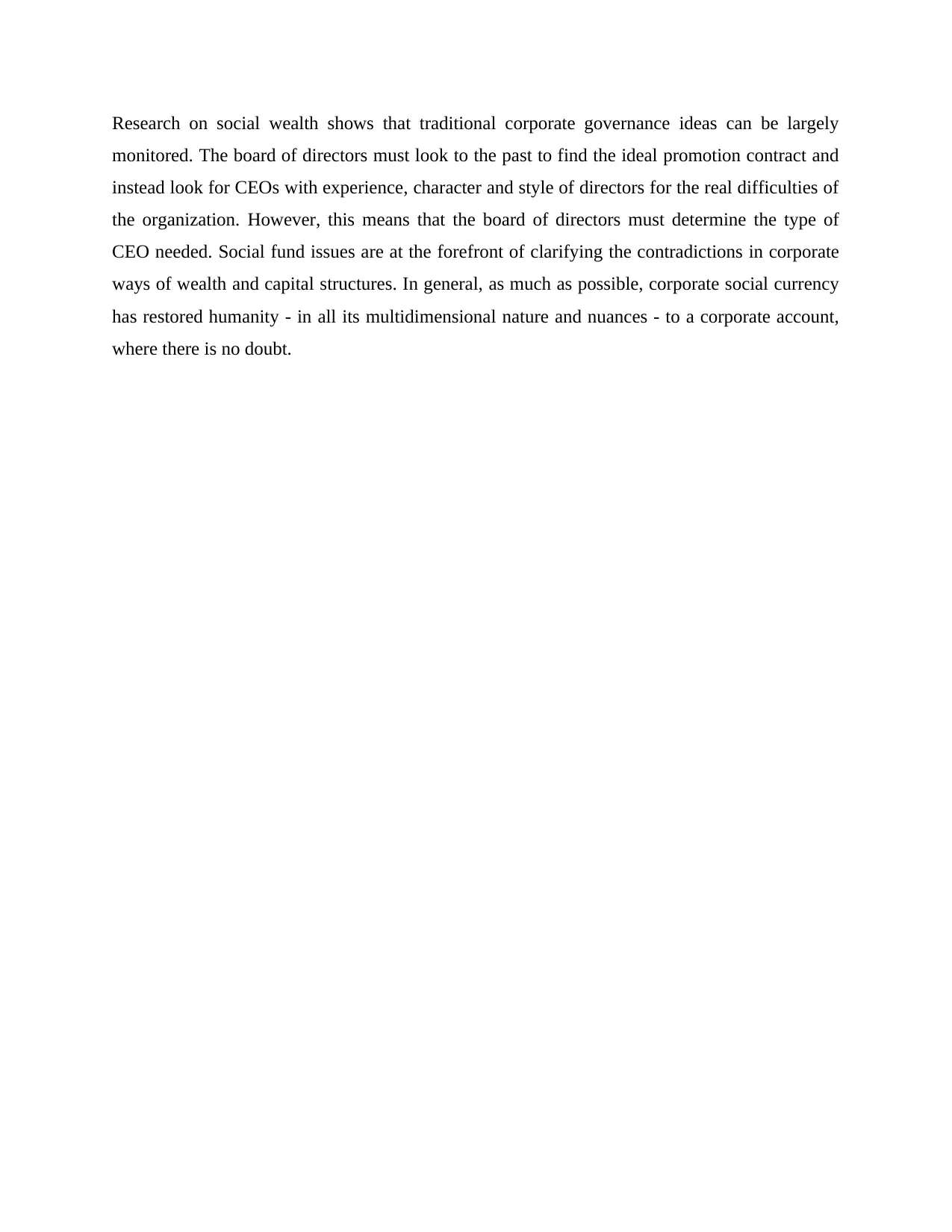
Research on social wealth shows that traditional corporate governance ideas can be largely
monitored. The board of directors must look to the past to find the ideal promotion contract and
instead look for CEOs with experience, character and style of directors for the real difficulties of
the organization. However, this means that the board of directors must determine the type of
CEO needed. Social fund issues are at the forefront of clarifying the contradictions in corporate
ways of wealth and capital structures. In general, as much as possible, corporate social currency
has restored humanity - in all its multidimensional nature and nuances - to a corporate account,
where there is no doubt.
monitored. The board of directors must look to the past to find the ideal promotion contract and
instead look for CEOs with experience, character and style of directors for the real difficulties of
the organization. However, this means that the board of directors must determine the type of
CEO needed. Social fund issues are at the forefront of clarifying the contradictions in corporate
ways of wealth and capital structures. In general, as much as possible, corporate social currency
has restored humanity - in all its multidimensional nature and nuances - to a corporate account,
where there is no doubt.
Paraphrase This Document
Need a fresh take? Get an instant paraphrase of this document with our AI Paraphraser
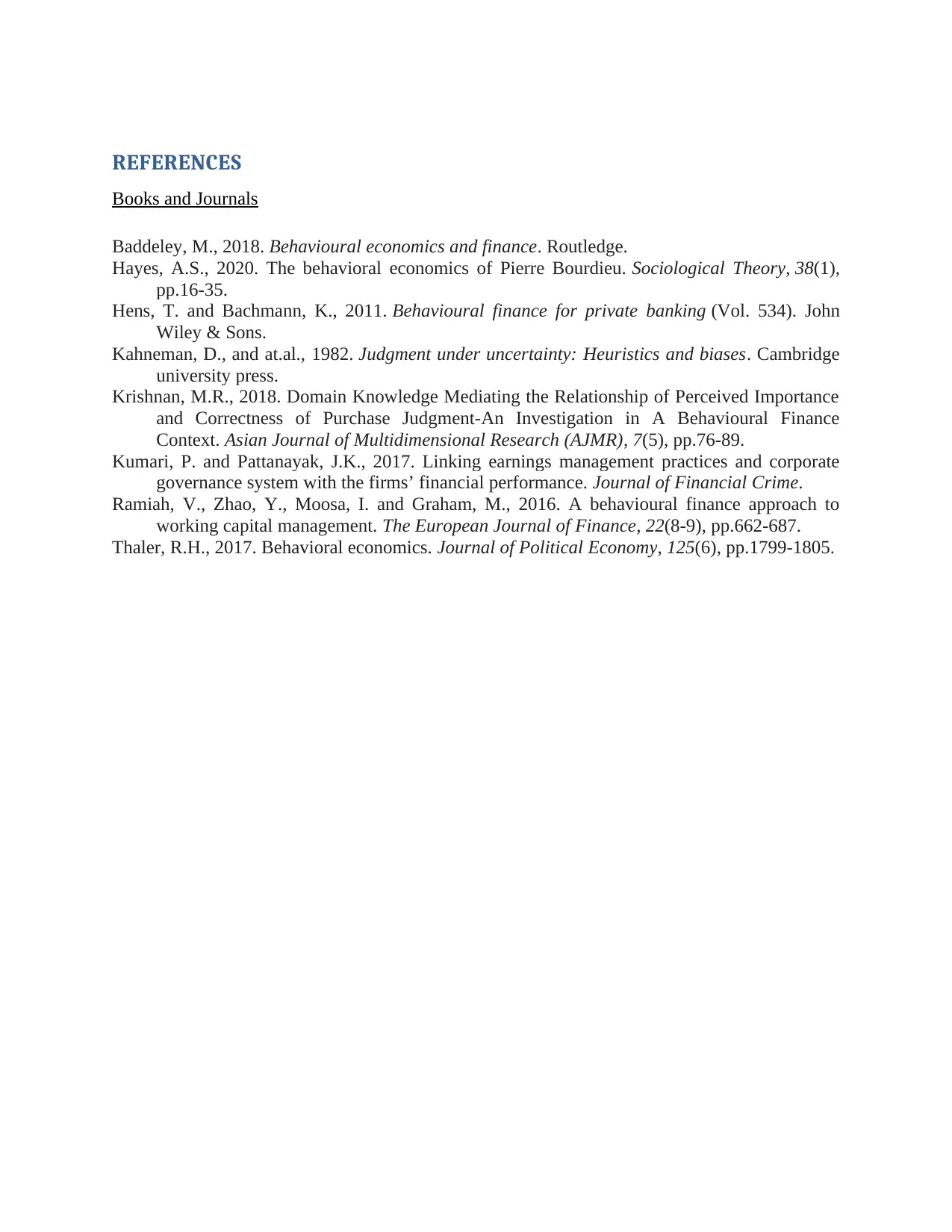
REFERENCES
Books and Journals
Baddeley, M., 2018. Behavioural economics and finance. Routledge.
Hayes, A.S., 2020. The behavioral economics of Pierre Bourdieu. Sociological Theory, 38(1),
pp.16-35.
Hens, T. and Bachmann, K., 2011. Behavioural finance for private banking (Vol. 534). John
Wiley & Sons.
Kahneman, D., and at.al., 1982. Judgment under uncertainty: Heuristics and biases. Cambridge
university press.
Krishnan, M.R., 2018. Domain Knowledge Mediating the Relationship of Perceived Importance
and Correctness of Purchase Judgment-An Investigation in A Behavioural Finance
Context. Asian Journal of Multidimensional Research (AJMR), 7(5), pp.76-89.
Kumari, P. and Pattanayak, J.K., 2017. Linking earnings management practices and corporate
governance system with the firms’ financial performance. Journal of Financial Crime.
Ramiah, V., Zhao, Y., Moosa, I. and Graham, M., 2016. A behavioural finance approach to
working capital management. The European Journal of Finance, 22(8-9), pp.662-687.
Thaler, R.H., 2017. Behavioral economics. Journal of Political Economy, 125(6), pp.1799-1805.
Books and Journals
Baddeley, M., 2018. Behavioural economics and finance. Routledge.
Hayes, A.S., 2020. The behavioral economics of Pierre Bourdieu. Sociological Theory, 38(1),
pp.16-35.
Hens, T. and Bachmann, K., 2011. Behavioural finance for private banking (Vol. 534). John
Wiley & Sons.
Kahneman, D., and at.al., 1982. Judgment under uncertainty: Heuristics and biases. Cambridge
university press.
Krishnan, M.R., 2018. Domain Knowledge Mediating the Relationship of Perceived Importance
and Correctness of Purchase Judgment-An Investigation in A Behavioural Finance
Context. Asian Journal of Multidimensional Research (AJMR), 7(5), pp.76-89.
Kumari, P. and Pattanayak, J.K., 2017. Linking earnings management practices and corporate
governance system with the firms’ financial performance. Journal of Financial Crime.
Ramiah, V., Zhao, Y., Moosa, I. and Graham, M., 2016. A behavioural finance approach to
working capital management. The European Journal of Finance, 22(8-9), pp.662-687.
Thaler, R.H., 2017. Behavioral economics. Journal of Political Economy, 125(6), pp.1799-1805.
1 out of 5
Related Documents
Your All-in-One AI-Powered Toolkit for Academic Success.
+13062052269
info@desklib.com
Available 24*7 on WhatsApp / Email
![[object Object]](/_next/static/media/star-bottom.7253800d.svg)
Unlock your academic potential
Copyright © 2020–2025 A2Z Services. All Rights Reserved. Developed and managed by ZUCOL.




